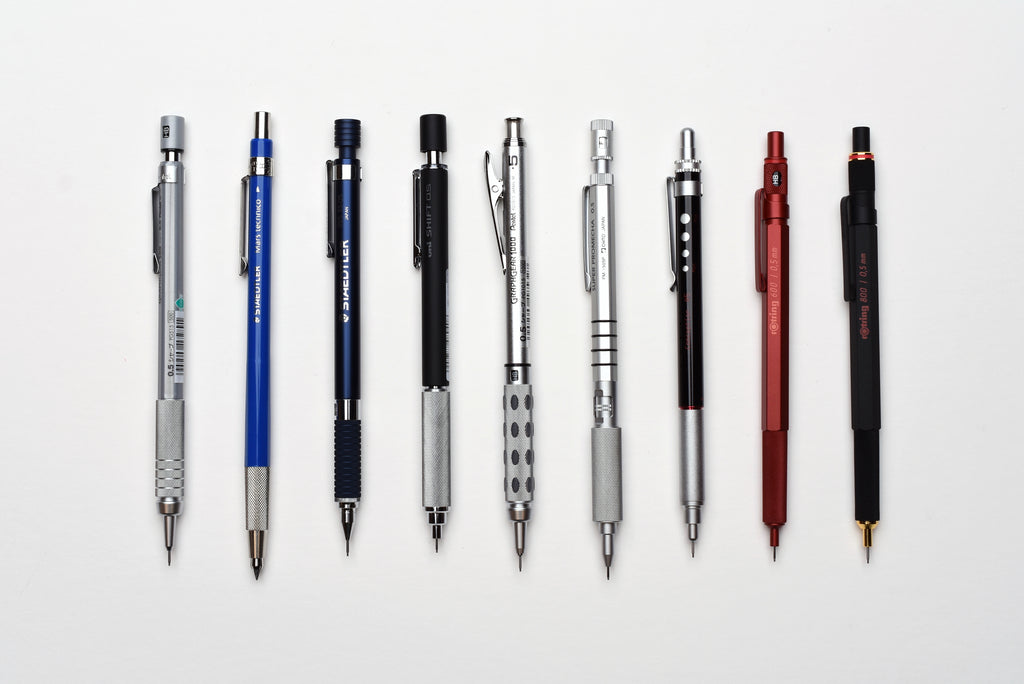Hi! This is Jane, and I'm here to talk about the mechanical drafting pencil! If you’re a designer, architect, engineer, or simply prefer the sharpest of writing instruments, you’re likely already familiar with this one, but I'll try to cover some tidbits you may not know yet. This tool was originally designed for analog technical drawing, but pencil users who prioritize precision, durability, and practicality have grown to love this type of mechanical pencil for everyday use. I was introduced to my first drafting pencil (a Pentel GraphGear 500 in 0.5mm) by a calculus professor in college, and I never looked back.

Pictured left to right, in ascending price order, are the Pentel GraphGear 500, Staedtler Mars (in store only), Staedtler 925-35, Uni Shift, Pentel GraphGear1000, Ohto Super Promecha, Ohto Conception, Rotring 600, and Rotring 800 mechanical drafting pencils.
A good drafting pencil is made of durable metal and/or plastic, has a unique tip that gives you full visibility of what you're writing/drawing, especially when paired with a straightedge or protractor, and can accommodate a variety of lead sizes for the exact level of precision you need. Below, I’ll explain these characteristics, which are laid out on the vertical axis of the table:
1. Longer-than-usual lead guide: The lead guide, also called a lead sleeve, is the thin metal tube that holds the exposed lead. The average all-purpose mechanical pencil has a lead guide that's about 2.5-3mm; however, many drafting pencils boast a lead guide that's as long as 4mm. The extra length prevents frequent lead breakage and allows you to draw comfortably alongside a ruler, protractor, or the like. For reference, here is the
Rotring 800's 4mm lead guide.

2. Retractable lead guide: Many drafting pencils allow you to retract the lead guide when you’re not using the pencil, which preserves the fine lead tip from snapping off in transit. This also makes for a cleaner pencil case or shirt pocket!
True to its name, the
Uni Shift (pictured below) features
a neat shift-and-lock mechanism that hides the lead guide away when not in use. The Pentel GraphGear 1000 has a functional clip that also doubles as a button to retract its lead guide. The Rotring 800 also hides/reveals its lead guide with a twist of its upper barrel.


3. Lead grade indicator: This is a small window on the body of your pencil that you can adjust as you please. If you like to switch between HB and B, the lead grade indicator can remind you which type of lead your pencil is carrying at the moment.

4. Availability for lead sizes: This one is a no-brainer. Whether you're drafting intricate diagrams or scrawling down notes, it's important to be able to choose the lead thickness of your preference. The most common range offered by most drafting pencils is 0.3mm to 2.0mm.
5. Knurled or cushioned grip: Drafting pencils are designed for prolonged periods of usage, and that means comfort is key. A knurled grip on a metal body adds texture for an easy grip, but you may prefer a more traditional rubber-cushioned grip. For those who can’t decide between these options, the Pentel GraphGear 1000 (furthest right in the picture below) sports a hybrid knurled and cushioned grip that makes for a very comfortable grip.

6. Weighted metal body (low center of gravity): If you’re using a drafting pencil for the first time, you might be taken aback by how bottom-heavy it is. But this low center of gravity is designed to reduce wobble, stabilizing your hand as you draw straight lines or curves. The Staedtler 925-35, which only has a very slightly weighted grip, may be friendlier for casual users; on the other hand, the Rotring 600 and Rotring 800 have some more heft if that's what you're looking for.
And there are, of course, a couple drafting pencils that go above and beyond the call of duty. Here are some extra perks that may pique your interest if you're looking for a truly unique drafting pencil:
7. Adjustable lead guide length: The Ohto Super Promecha and the Ohto Conception both feature barrel grips that you can rotate to customize the length of the lead guide anywhere between 0.1mm and 4mm.

8. Adjustable lead feed: The Ohto Super Promecha and the Ohto Conception also allow you to adjust the fixed amount of lead that is dispensed per click -- anywhere from 0.2mm to 2mm -- by turning a dial on the body of the pencil.
9. Special lead advancement mechanism: The Staedtler Mars Technico (available in store only) features a drop-clutch mechanism that allows you to easily adjust the amount of lead dispensed with every click; simply press down to release the clutch and dispense as much lead as you need. The Ohto Conception (an overachiever!) has a unique “lead guard mode” that transforms the lead sleeve into one that shifts continuously during use, meaning you have to manually click to dispense more lead much less frequently than average. This mode adapts the pencil to especially long writing or drawing sessions.

The table below takes a closer look at these nine mechanical drafting pencils and organizes them on the nine characteristics/criteria I discussed above, so you can see at a glance what drafting pencil may be best suited to your needs. Hope you find this helpful!















